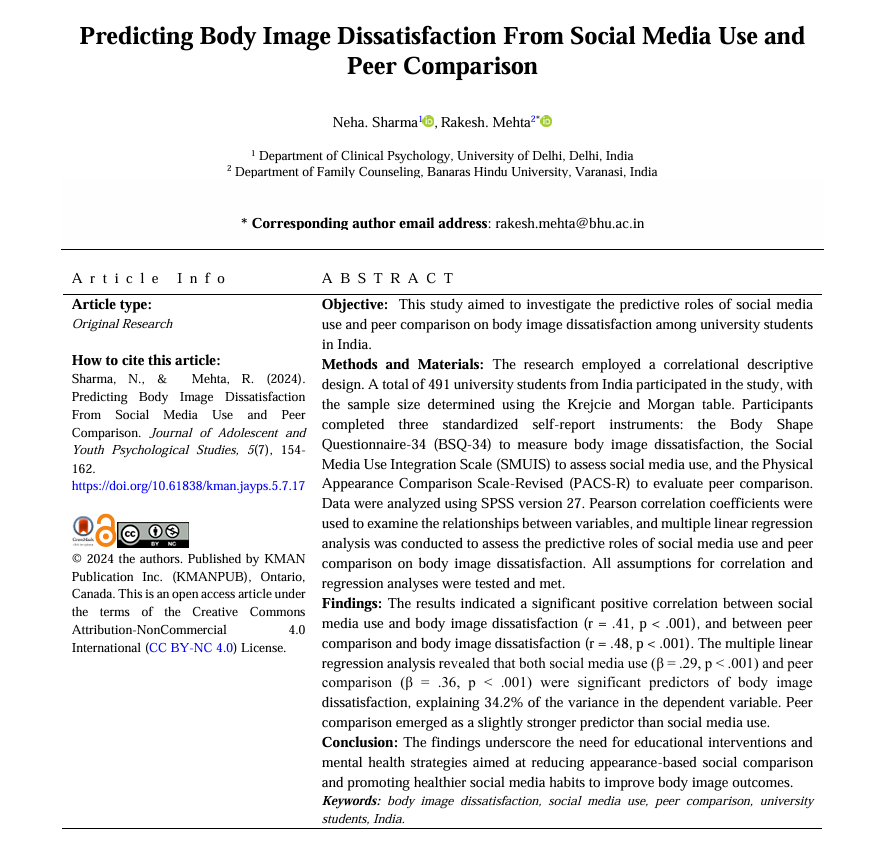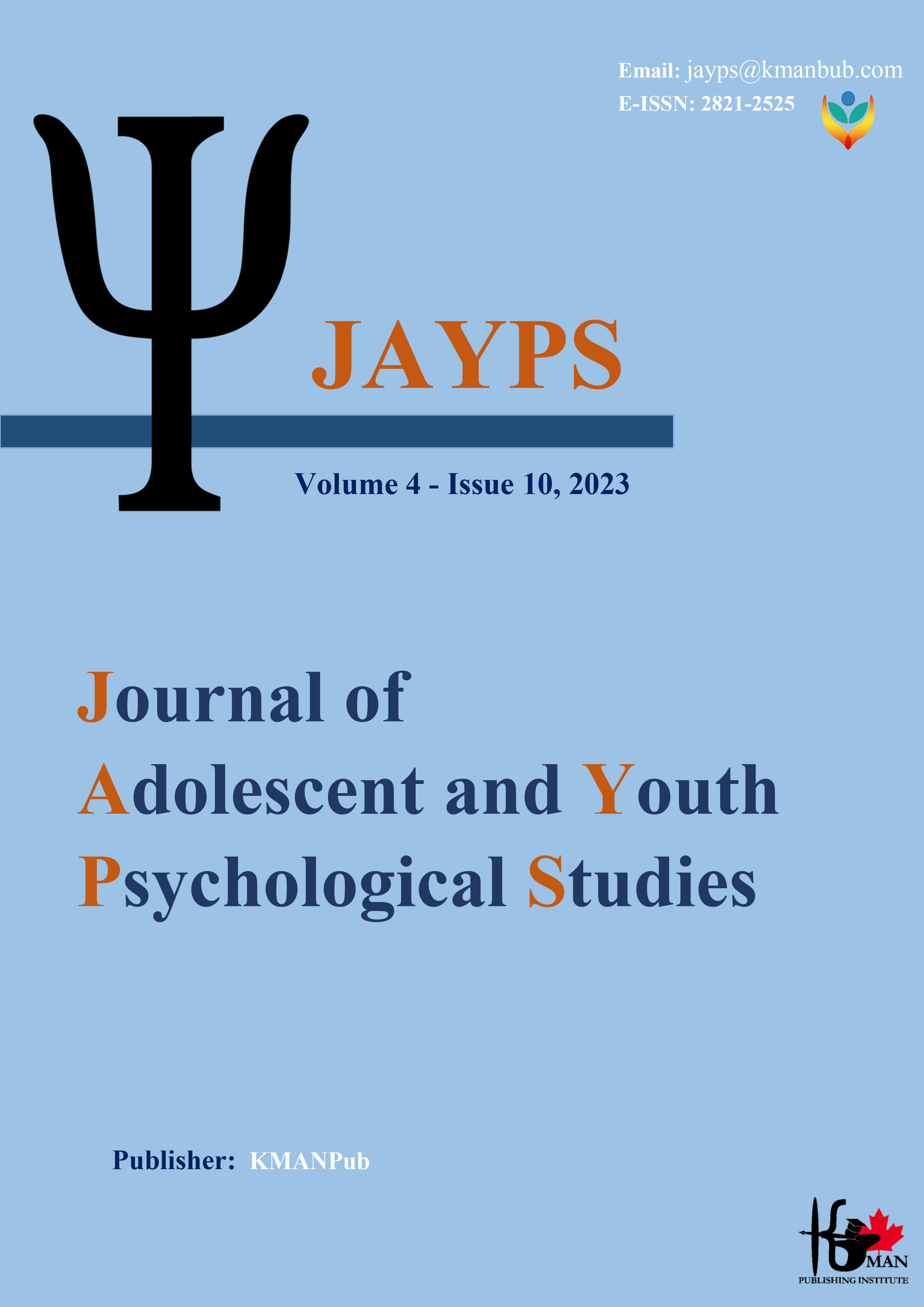Predicting Body Image Dissatisfaction From Social Media Use and Peer Comparison
Keywords:
body image dissatisfaction, social media use, peer comparison, university students, IndiaAbstract
Objective: This study aimed to investigate the predictive roles of social media use and peer comparison on body image dissatisfaction among university students in India.
Methods and Materials: The research employed a correlational descriptive design. A total of 491 university students from India participated in the study, with the sample size determined using the Krejcie and Morgan table. Participants completed three standardized self-report instruments: the Body Shape Questionnaire-34 (BSQ-34) to measure body image dissatisfaction, the Social Media Use Integration Scale (SMUIS) to assess social media use, and the Physical Appearance Comparison Scale-Revised (PACS-R) to evaluate peer comparison. Data were analyzed using SPSS version 27. Pearson correlation coefficients were used to examine the relationships between variables, and multiple linear regression analysis was conducted to assess the predictive roles of social media use and peer comparison on body image dissatisfaction. All assumptions for correlation and regression analyses were tested and met.
Findings: The results indicated a significant positive correlation between social media use and body image dissatisfaction (r = .41, p < .001), and between peer comparison and body image dissatisfaction (r = .48, p < .001). The multiple linear regression analysis revealed that both social media use (β = .29, p < .001) and peer comparison (β = .36, p < .001) were significant predictors of body image dissatisfaction, explaining 34.2% of the variance in the dependent variable. Peer comparison emerged as a slightly stronger predictor than social media use.
Conclusion: The findings underscore the need for educational interventions and mental health strategies aimed at reducing appearance-based social comparison and promoting healthier social media habits to improve body image outcomes.
Downloads
References
Abdulwahab, I. J., Khouja, J. H., Alzahrani, N. A., & Bargawi, A. (2024). Social Media Use and Body Image Dissatisfaction Among University Students of Health Sciences in Saudi Arabia. Cureus. https://doi.org/10.7759/cureus.74889
Apopei, D., Coe, J., & Cordoba, S. (2024). Examining the Role of Family, Media, Peers in Young Caucasian Men’s Understandings of Body Dissatisfaction: A Thematic Analysis Using the Tripartite Influential Model and Social Comparison Theory. Gender Issues, 41(4). https://doi.org/10.1007/s12147-024-09339-3
Bilal, A., Wazir, S., & Farooq, B. (2021). Relationship Between Body Image Dissatisfaction and Social Media Usage in Young Women. Pakistan Journal of Humanities and Social Sciences, 9(3). https://doi.org/10.52131/pjhss.2021.0903.0151
Charmaraman, L., Richer, A. M., Liu, C. H., Lynch, A. D., & Moreno, M. A. (2021). Early Adolescent Social Media–Related Body Dissatisfaction: Associations With Depressive Symptoms, Social Anxiety, Peers, and Celebrities. Journal of Developmental & Behavioral Pediatrics, 42(5), 401-407. https://doi.org/10.1097/dbp.0000000000000911
Dondzilo, L., Basanovic, J., Grafton, B., Bell, J., Turnbull, G., & MacLeod, C. (2021). A Serial Mediation Model of Attentional Engagement With Thin Bodies on Body Dissatisfaction: The Role of Appearance Comparisons and Rumination. Current Psychology. https://doi.org/10.1007/s12144-021-01574-1
Fardouly, J., Pinkus, R. T., & Vartanian, L. R. (2017). The impact of appearance comparisons made through social media, traditional media, and in person in women’s everyday lives. Body Image, 20, 31-39. https://doi.org/10.1016/j.bodyim.2016.11.002
Górska, D., Świercz, K., Majcher, M., Sierpień, M., Majcher, M., Pikulicka, A., Karwańska, A., Kulbat, A., Brzychczy, P., & Kulbat, M. (2023). Influence of Social Media on Developing Body Image Dissatisfaction and Eating Disorders. Journal of Education Health and Sport, 22(1), 56-62. https://doi.org/10.12775/jehs.2023.22.01.005
Griffiths, S., Murray, S. B., Krug, I., & McLean, S. A. (2018). The Contribution of Social Media to Body Dissatisfaction, Eating Disorder Symptoms, and Anabolic Steroid Use Among Sexual Minority Men. Cyberpsychology Behavior and Social Networking, 21(3), 149-156. https://doi.org/10.1089/cyber.2017.0375
Hashim, N., Munir, N. A. N. H., Nur AfiqahNur Afiqah Ahmad, T., & Ahmad, N. F. I. (2022). Dissatisfaction About Body Image During Social Networking Among University Students. The Malaysian Journal of Nursing, 13(04), 12-18. https://doi.org/10.31674/mjn.2022.v13i04.003
Jiotsa, B., Naccache, B., Duval, M., Rocher, B., & Grall‐Bronnec, M. (2021). Social Media Use and Body Image Disorders: Association Between Frequency of Comparing One’s Own Physical Appearance to That of People Being Followed on Social Media and Body Dissatisfaction and Drive for Thinness. International journal of environmental research and public health, 18(6), 2880. https://doi.org/10.3390/ijerph18062880
Kalinin, V. N., & Edgüer, N. (2023). The Effects of Self-Control and Self-Awareness on Social Media Usage, Self-Esteem, and Affect. Eureka, 8(1). https://doi.org/10.29173/eureka28781
Lin, W. C., Cen, Z., & Chen, Y. (2025). The Impact of Social Media Addiction on the Negative Emotions of Adolescent Athletes: The Mediating Role of Physical Appearance Comparisons and Sleep. Frontiers in Public Health, 12. https://doi.org/10.3389/fpubh.2024.1452769
Liu, J. (2022). Social Media and Its Impact on Chinese’s Women Body Image: The Effects of Body Comparison and Motivation for Social Media Use. https://doi.org/10.2991/assehr.k.220110.040
Lukman, F. A., Muis, I., & Hamid, A. N. (2023). The Effect of Social Media Use Intensity on Body Image Dissatisfaction in Early Adult Women. Indigenous Jurnal Ilmiah Psikologi, 8(3), 314-324. https://doi.org/10.23917/indigenous.v8i3.2587
Mironica, A., Popescu, C. A., George, D., Tegzeșiu, A. M., & Gherman, C. (2024). Social Media Influence on Body Image and Cosmetic Surgery Considerations: A Systematic Review. Cureus. https://doi.org/10.7759/cureus.65626
Möri, M., Mongillo, F., & Fahr, A. (2022). Images of Bodies in Mass and Social Media and Body Dissatisfaction: The Role of Internalization and Self-Discrepancy. Frontiers in psychology, 13. https://doi.org/10.3389/fpsyg.2022.1009792
Mumber, H., Rashid, S., Carey, G., Navarro, A., Oh, E., Nasir, M., & Lee, M. (2022). Impact of a Comfortable in Our Skin Interactive Workshop on Social Media Awareness and self‐confidence in Adolescents. Pediatric Dermatology, 39(4), 553-556. https://doi.org/10.1111/pde.15011
Navadiya, K., Rafi, S., Harvansh, B., Shamatmika, R., & Sharma, V. K. (2024). How Social Media Impacts Promotion of Body Image Dissatisfaction Among Youth. International Journal of Innovative Science and Research Technology, 3257-3281. https://doi.org/10.38124/ijisrt/ijisrt24jul1874
Olatona, F. A., Kolanisi, U., & Onselen, A. V. (2024). Body Image Dissatisfaction, Disordered Eating Attitudes and Nutritional Status Among Female Undergraduate Students in Lagos, Nigeria. African Journal of Food Agriculture Nutrition and Development, 24(2), 25426-25449. https://doi.org/10.18697/ajfand.127.23625
Panzitta, M. T., Labory, J. P., Anger, V., Chulibert, M. E., Mayer, M., & Kalfaian, L. (2023). Influencia Del Uso De Redes Sociales Sobre La Conformidad Con La Imagen Corporal. Actualización en Nutrición, 24(2). https://doi.org/10.48061/san.2022.24.2.109
Pattamarruk, P., Pisitsungkagarn, K., Jarukasemthawee, S., & Leangsuksant, T. (2020). The Mediating Role of Media Internalization in Body Scrutinization and Body Image Dissatisfaction in Thai Homosexual Male Youth. The Journal of Social Sciences Research(64), 446-451. https://doi.org/10.32861/jssr.64.446.451
Putri, B. B. K., & Ninin, R. H. (2023). Dynamics of Body Image Formation in Female Celebrities. Daengku Journal of Humanities and Social Sciences Innovation, 3(3), 443-450. https://doi.org/10.35877/454ri.daengku1688
Riyami, Y. S. A., Senani, I. H. A., Brashdi, A. S. A., Balushi, N. I. A., Almarabheh, A., & Ahmed, J. (2024). Young Females Experience Higher Body Image Dissatisfaction Associated With a High Social Media Use: A Cross-Sectional Study in Omani University Students. Middle East Current Psychiatry, 31(1). https://doi.org/10.1186/s43045-024-00477-8
Sabol, M. A., & Duell, N. (2024). Effects of Social Media Use on Body Image and Disordered Eating in Adolescents. https://doi.org/10.31234/osf.io/fxh6m
Tufail, M. W., Saleem, M., & Fatima, S. Z. (2022). Relationship of Social Media and Body Image Dissatisfaction Among University Students. Pakistan Journal of Applied Psychology, 2(1). https://doi.org/10.52461/pjap.v2i1.1041
Vuong, A., Jarman, H. K., Doley, J. R., & McLean, S. A. (2021). Social Media Use and Body Dissatisfaction in Adolescents: The Moderating Role of Thin- And Muscular-Ideal Internalisation. International journal of environmental research and public health, 18(24), 13222. https://doi.org/10.3390/ijerph182413222
Zhou, C. (2024). The Influence of Social Media Use on Females’ Body Anxiety. Hc, 1(10). https://doi.org/10.61173/9hbvm548
Zhu, Y. (2023). The Influence of Social Media on Adolescent Body Image Ideals: A Study of Middle School Students in Guangzhou-Foshan, China. Advances in Applied Sociology, 13(08), 604-621. https://doi.org/10.4236/aasoci.2023.138038

Downloads
Additional Files
Published
Submitted
Revised
Accepted
Issue
Section
License

This work is licensed under a Creative Commons Attribution-NonCommercial 4.0 International License.








